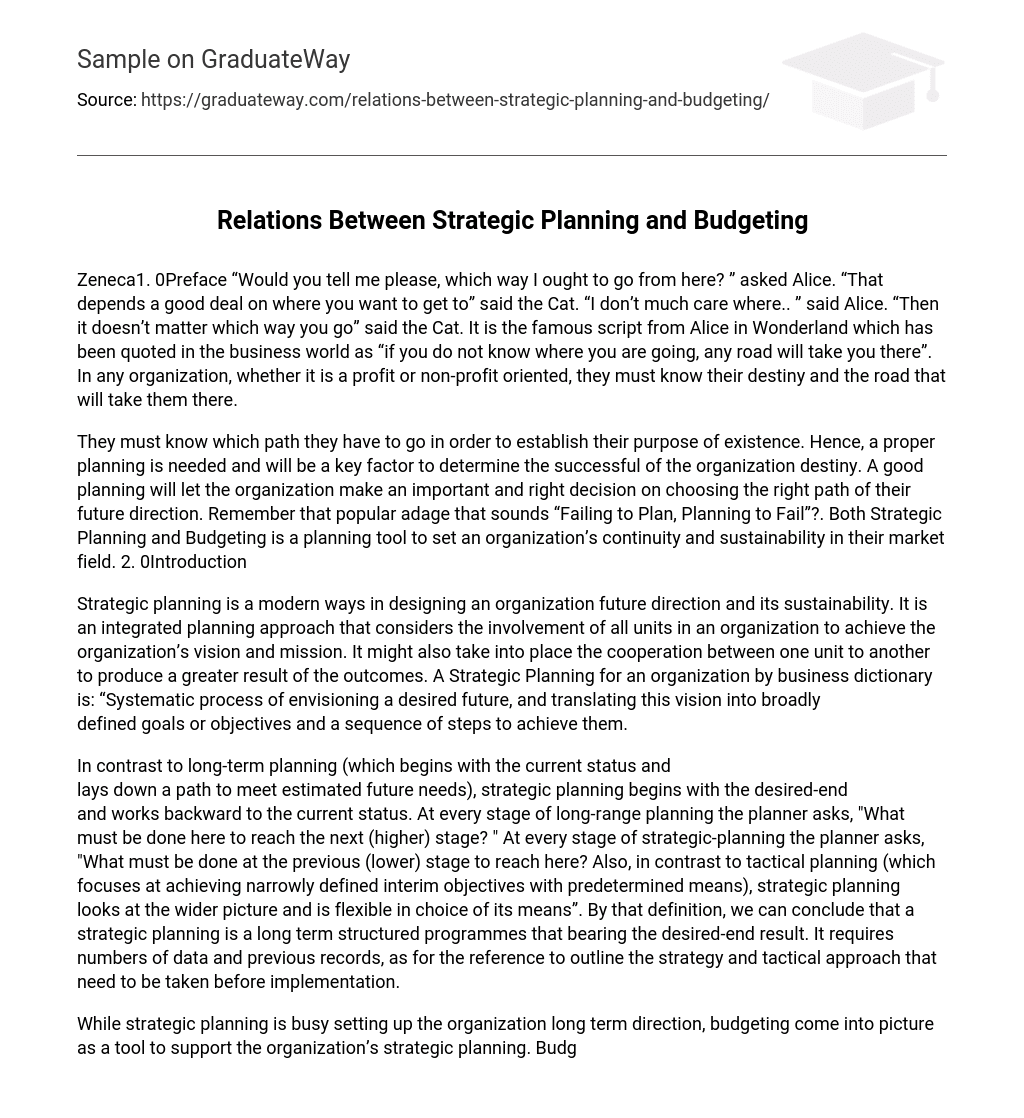“Would you tell me please, which way I ought to go from here? ” asked Alice. “That depends a good deal on where you want to get to” said the Cat. “I don’t much care where.. ” said Alice. “Then it doesn’t matter which way you go” said the Cat. It is the famous script from Alice in Wonderland which has been quoted in the business world as “if you do not know where you are going, any road will take you there”. In any organization, whether it is a profit or non-profit oriented, they must know their destiny and the road that will take them there.
They must know which path they have to go in order to establish their purpose of existence. Hence, a proper planning is needed and will be a key factor to determine the successful of the organization destiny. A good planning will let the organization make an important and right decision on choosing the right path of their future direction. Remember that popular adage that sounds “Failing to Plan, Planning to Fail”?. Both Strategic Planning and Budgeting is a planning tool to set an organization’s continuity and sustainability in their market field.
Strategic planning is a modern ways in designing an organization future direction and its sustainability. It is an integrated planning approach that considers the involvement of all units in an organization to achieve the organization’s vision and mission. It might also take into place the cooperation between one unit to another to produce a greater result of the outcomes. A Strategic Planning for an organization by business dictionary is: “Systematic process of envisioning a desired future, and translating this vision into broadly defined goals or objectives and a sequence of steps to achieve them.
In contrast to long-term planning (which begins with the current status and lays down a path to meet estimated future needs), strategic planning begins with the desired-end and works backward to the current status. At every stage of long-range planning the planner asks, “What must be done here to reach the next (higher) stage? ” At every stage of strategic-planning the planner asks, “What must be done at the previous (lower) stage to reach here? Also, in contrast to tactical planning (which focuses at achieving narrowly defined interim objectives with predetermined means), strategic planning looks at the wider picture and is flexible in choice of its means”. By that definition, we can conclude that a strategic planning is a long term structured programmes that bearing the desired-end result. It requires numbers of data and previous records, as for the reference to outline the strategy and tactical approach that need to be taken before implementation.
While strategic planning is busy setting up the organization long term direction, budgeting come into picture as a tool to support the organization’s strategic planning. Budgeting is needed to ensure all the activities and action plan designed in strategic planning, are running smoothly and effectively. Budgeting will be functioning as a financing element as to facilitate all the activities that has been planned. Budgeting will also be a tool to monitor and measure the performance of the organization in a day to day operation.
Libby & Lindsay, Part 1, 2003 describe budgeting as : “To motivate employees, allocate resources and coordinate operations within organization are, and have been the primary purpose of budget. Budgeting is aimed to facilitate responsibility distribution and is used to evaluate performance. 3. 0Relationship between Budgeting and Strategic Planning for an Organization. It is with no doubt that a budgeting is prepared for a purpose. In this case, a budgeting is prepared for a strategic planning purpose.
Both budgeting and strategic planning is inter-related and must be planned accordingly in order to justify whether an organization’s strategic plan is executable, workable, measureable and more importantly is meeting the organization’s vision, mission and objective. The relationship between budgeting and strategic planning lies as below: a) The budget will inform the organization how much money they need, to carry out the activities planned in the strategic planning. b) The budget will let the organization thinks the implications of the activity planning.
It will help the organization making some adjustment if the implication looks like to be failed. It will enable the organization make an income and expenditure projection and identifies any problems that might happen. A basis for organization’s accountability and transparency. Any discrepancies can be identified by looking into the amount received and spent is equal to activities being carried out. Most bankers or financial institution give loans based on the organization well planned activities.
None of these two can be stand alone because strategic planning need budgeting to materialise the activities that has been planned while budgeting need strategic planning to know for what purpose it is being used. As strategic planning helps the organisation establish its existence, a budgeting helps the organizations establish its continuity and sustainability.





